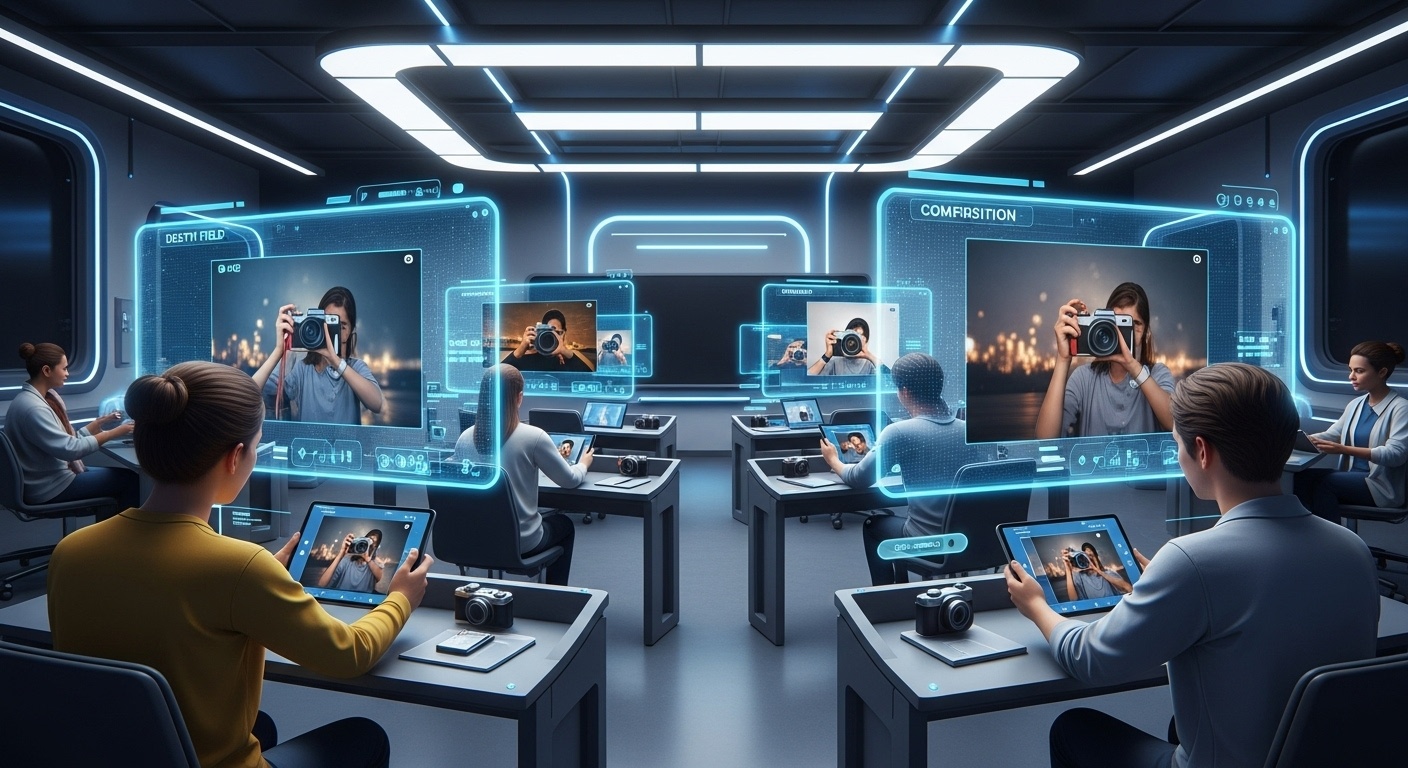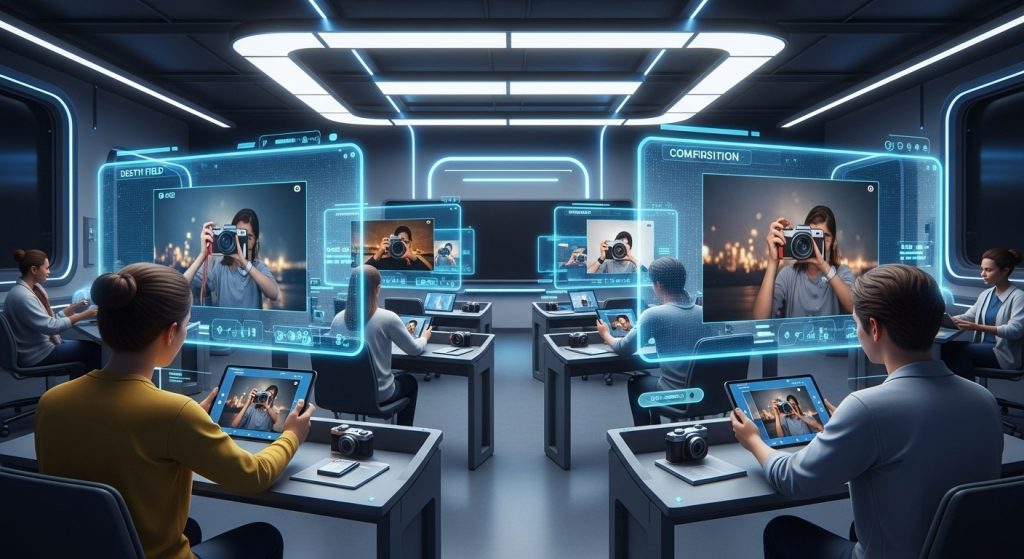In 2025, mastering photography demands navigating AI-powered editing tools and understanding the ethics of deepfake imagery alongside traditional techniques. This curriculum equips students with core skills from lighting and composition to advanced post-processing using platforms like Luminar AI and Capture One. We delve into emerging fields such as computational photography, enabling students to create images beyond human perception. Explore the nuances of drone photography for unique perspectives. Students will also critically examine visual storytelling’s evolving role in a world saturated with synthetic media, preparing them to be responsible and innovative visual communicators in a rapidly changing landscape.

Core Foundational Skills: The Bedrock of Visual Storytelling
A robust photography curriculum must begin with a firm understanding of the fundamentals. This section lays the groundwork for all advanced techniques and creative explorations.
- History of Photography: Understanding the evolution of photography, from the camera obscura to digital sensors, provides context for current practices. Students should study the works of pioneering photographers like Daguerre, Talbot. Eastman. Examine the impact of historical movements on photographic styles.
- Camera Operation and Controls: Mastery of camera settings is essential. This includes aperture, shutter speed, ISO, white balance. Metering modes. Students will learn how these settings interact to control exposure, depth of field. Motion blur. Practical exercises will involve shooting in various lighting conditions and scenarios.
- Lens Selection and Perspective: Different lenses offer unique perspectives and creative possibilities. The curriculum should cover various lens types (wide-angle, standard, telephoto, macro) and their applications. Students will learn about focal length, depth of field. Perspective distortion. How to use these elements to enhance their compositions.
- Composition and Design Principles: Strong composition is crucial for creating visually compelling images. Students will learn about the rules of composition, such as the rule of thirds, leading lines, symmetry. Balance. They will also explore elements of design, including line, shape, form, texture, color. Space.
Digital Workflow and Image Management
In the digital age, a solid understanding of digital workflow is paramount. This module focuses on efficient file management, image processing. Archiving techniques.
- Digital Asset Management (DAM): Students will learn how to organize, tag. Archive their images using DAM software like Adobe Lightroom or Capture One. This includes creating folder structures, applying metadata. Developing efficient search strategies.
- Image Editing Software (Adobe Photoshop & Alternatives): Proficiency in image editing software is vital for enhancing and manipulating photographs. The curriculum should cover essential editing techniques, such as exposure correction, color adjustments, retouching. Sharpening. Students will also learn about advanced techniques, such as layers, masking. Blending modes. Alternatives like Affinity Photo and GIMP should also be introduced to offer a broader perspective on available tools.
- Color Management: Understanding color spaces, profiles. Calibration is crucial for accurate color reproduction. Students will learn how to calibrate their monitors, create color profiles. Manage color workflows to ensure consistent results across different devices.
- File Formats and Resolution: Knowledge of different file formats (JPEG, TIFF, RAW) and their characteristics is essential for optimizing images for various purposes. Students will learn about resolution, pixel dimensions. Compression techniques.
Lighting: Shaping the Visual Narrative
Lighting is the cornerstone of photography. This module explores various lighting techniques, both natural and artificial. Their impact on mood and visual storytelling.
- Natural Light Photography: Understanding how to utilize natural light is essential for any photographer. Students will learn how to identify and work with different types of natural light, such as direct sunlight, diffused light. Golden hour light. They will also learn how to use reflectors and diffusers to modify natural light.
- Studio Lighting Techniques: This section focuses on artificial lighting techniques using strobes, speedlights. Continuous lights. Students will learn about different lighting patterns, such as Rembrandt lighting, butterfly lighting. Split lighting. They will also learn how to use light modifiers, such as umbrellas, softboxes. Grids.
- On-Location Lighting: Combining natural and artificial light sources to create compelling images in uncontrolled environments. This includes balancing ambient light with flash, using portable lighting equipment effectively. Troubleshooting common lighting challenges.
- Light Metering and Exposure Control: Mastering the use of light meters is crucial for accurate exposure. Students will learn about different metering modes and how to interpret light meter readings. They will also learn how to use exposure compensation to fine-tune their exposures.
Genre Specialization: Finding Your Photographic Voice
This module allows students to explore different photographic genres and develop their own unique style and expertise.
- Portrait Photography: Capturing the essence of a person through careful posing, lighting. Expression. This includes studio portraiture, environmental portraiture. Candid portraiture. Ethical considerations regarding retouching and representation are also discussed.
- Landscape Photography: Showcasing the beauty and grandeur of the natural world. This includes techniques for capturing wide-angle landscapes, panoramic images. Detailed close-ups. The importance of conservation and responsible land use is emphasized.
- Photojournalism and Documentary Photography: Telling stories through images, documenting social issues. Capturing historical events. This requires a strong ethical code, objectivity. The ability to work under pressure.
- Commercial Photography: Creating images for advertising, marketing. Editorial purposes. This includes product photography, fashion photography. Food photography. Students will learn about working with clients, creating briefs. Managing budgets.
- Fine Art Photography: Exploring photography as a form of artistic expression. This allows students to experiment with different techniques, styles. Concepts.
Advanced Techniques and Emerging Technologies
Staying current with technological advancements is essential for success in the ever-evolving field of photography.
- High Dynamic Range (HDR) Photography: Combining multiple exposures to create images with a wider dynamic range. Students will learn how to capture HDR images and process them using software like Adobe Lightroom or Photomatix.
- Panoramic Photography: Creating wide-angle images by stitching together multiple photographs. Students will learn how to capture panoramic images and stitch them using software like Adobe Photoshop or PTGui.
- Time-Lapse Photography: Capturing a series of photographs over time to create a time-lapse video. Students will learn how to set up their cameras for time-lapse photography and process the images using software like Adobe Lightroom or LRTimelapse.
- Computational Photography: Exploring techniques that use software algorithms to enhance or manipulate images, such as focus stacking, perspective correction. Content-aware fill.
- Artificial Intelligence (AI) in Photography: Understanding the role of AI in tasks like image recognition, object detection. Automated editing. Ethical considerations regarding AI-generated content and its impact on the profession are discussed.
- Virtual Reality (VR) and 360° Photography: Creating immersive photographic experiences for virtual reality headsets and online platforms. This includes capturing 360° images and videos, stitching them together. Optimizing them for VR viewing.
Business and Professional Practices
A successful photography career requires not only artistic talent but also a strong understanding of business principles.
- Portfolio Development: Creating a professional portfolio that showcases your best work and highlights your skills and expertise. Students will learn how to select images for their portfolio, organize them effectively. Present them in a visually appealing manner.
- Marketing and Branding: Developing a strong brand identity and marketing your photography services to potential clients. This includes creating a website, using social media effectively. Networking with other professionals.
- Pricing and Negotiation: Determining appropriate pricing for your services and negotiating contracts with clients. Students will learn about different pricing models and how to calculate their costs and profits.
- Copyright and Intellectual Property: Understanding copyright law and protecting your intellectual property. Students will learn about registering their copyrights, licensing their images. Dealing with copyright infringement.
- Client Management and Communication: Building and maintaining strong relationships with clients. This includes effective communication, project management. Conflict resolution.
- Legal and Ethical Considerations: Adhering to ethical standards and complying with legal requirements. This includes obtaining model releases, respecting privacy. Avoiding plagiarism.
Critical Analysis and Visual Literacy
Developing a critical eye and understanding the language of visual communication is essential for becoming a well-rounded photographer.
- Image Deconstruction and Analysis: Learning to critically assess photographs, considering their technical aspects, composition. Context. Students will learn how to identify the strengths and weaknesses of an image and how to interpret its meaning.
- Visual Communication Theory: Understanding the principles of visual communication and how images convey meaning. This includes exploring semiotics, visual rhetoric. The psychology of perception.
- Photography Criticism and Writing: Developing the ability to write about photography in a clear, concise. Insightful manner. Students will learn how to write image reviews, essays. Exhibition critiques.
- Ethical Considerations in Photography: Examining the ethical implications of photography, including issues of representation, privacy. Manipulation. Students will learn how to make ethical decisions in their own work.
Conclusion
As you embark on this reimagined university photography journey, remember that technical skills are merely the foundation. The true power lies in your ability to see the world differently, to tell stories with light and shadow. To connect with your subjects on a human level. Embrace emerging technologies like AI-assisted editing. Never lose sight of the artistic vision that makes your work unique. Personally, I’ve found that the most impactful images come from unexpected moments and genuine connection. Don’t be afraid to experiment, to break the rules. To find your own voice. The photography landscape is constantly evolving, with trends like mobile storytelling and immersive experiences shaping the future. Stay curious, keep learning. Most importantly, keep creating. Your lens has the power to inspire, to provoke. To change the world. Go out there and use it! You can check out The Met’s Photography collection for inspiration.
More Articles
Crafting Compelling Statements: How to Make Your Application Truly Stand Out
Decoding University Admissions: Understanding Key Criteria for a Successful Application
Ace Your Entrance Exam: Proven Study Habits and Time Management Tips
Maximize Your Score: Effective Test-Taking Strategies for Entrance Exams
FAQs
So, what’s this ‘Essential University Photography Course Curriculum: A 2025 Guide’ thing all about? What makes it ‘essential’?
Think of it as the blueprint for a really solid photography education. ‘Essential’ because it focuses on the core skills and knowledge you absolutely need to thrive in the evolving photography world of 2025. We’re talking technical mastery, creative vision. A strong understanding of the industry – all baked into one curriculum.
Okay, cool. What kind of stuff would I actually learn in a course based on this guide?
Expect a mix! You’d definitely cover the basics: camera operation, lighting techniques (studio and natural), composition. Image editing. But it goes further, delving into things like visual storytelling, the ethics of photography, understanding different genres (portraiture, documentary, commercial). Even some business skills for photographers.
Is this just for people who want to be, like, professional photographers?
Not necessarily! While it’s great for aspiring pros, the skills you learn are valuable for anyone who wants to take their photography seriously. Think hobbyists, social media content creators, even people in fields like marketing or journalism. A strong visual sense is useful everywhere!
What about digital photography? Is film still a thing?
Absolutely! The curriculum would likely cover both digital and film photography. Digital is dominant now, of course, so there’ll be a heavy emphasis there. But understanding film photography – the mechanics, the chemistry, the history – can give you a deeper appreciation for the art form and inform your digital work.
How much emphasis is put on the ‘business’ side of things? Like, making money with my photos?
Good question! A modern curriculum should include a module on the business of photography. This could cover topics like pricing your work, marketing yourself, copyright, contracts. Building a portfolio. It’s not the main focus. It’s crucial knowledge for anyone hoping to turn their passion into a career.
What software would I be expected to learn?
Expect to become proficient in industry-standard software like Adobe Photoshop and Adobe Lightroom. These are the workhorses of digital image editing and management. You might also touch on other software depending on your specialization, such as Capture One or video editing programs.
Will the course just be lectures, or will there be hands-on stuff too?
Definitely hands-on! A good photography course relies heavily on practical assignments, critiques. Studio time. You’ll be spending a lot of time taking photos, experimenting with different techniques. Getting feedback on your work. Lectures provide the foundation. The real learning happens when you’re behind the camera.


